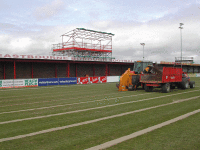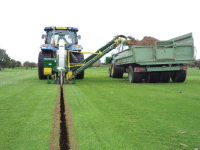The Drainage Game

Too often, pipe drainage systems are installed automatically, with not enough thought being given to the soil physics of water movement.
Soil is made of minerals originally derived from rock, and from organic matter from vegetation, water and air. Most of the soil is made of the mineral fraction derived from the parent material which is frequently located under the soil.
Most soils in the UK have formed on top of glacial or alluvial secondary deposits. This is frequently boulder clay derived from glacial erosion and deposition. However, the origination of all this material is from rock.

- Sand: 0.05mm-2.0mm
- Silt: 0.002mm-0.05mm
- Clay: <0.002mm
Soil Texture
This is a measure of the relative proportions of sand, silt and clay in a soil. Soils are often classified according to their texture and often provides a fair indication of how it will drain. The soil texture triangle is used to classify a soil based on the relative percentages of sand, silt and clay.
Structure

A well structured soil is usually characterised by an intensive system of small aggregates, or crumbs, gradually leading into larger blocks further down the soil profile.
Well structured soils are established on sites that have been left undisturbed for many years. The smaller particles in a soil form aggregates under the influence of clay, organic matter, earthworm activity and grass root activity.
How do these affect drainage?
Water moves through a soil in the spaces between the soil particles. These are called the pores. In a soil with a high clay and/or silt content, the pore spaces are very small, and are usually much larger in a sand dominated soil. A well structured soil contains a system of inter-connected very large pores that enables efficient water movement.

Barry Pace, contracts manager of Speedcut Contractors, says; "Breaking up compaction is one of the keys to keeping surfaces playable. As well as a good drainage system in place, surfaces that have become compacted will not let water through."
"Air injection systems, such as the Gwazae, push air in under force and break up compacted soil. Because the surface is hardly disturbed, it can be a good way of treating fine sportsturf areas like golf greens, around goalmouths and under racecourse jumps."
"The key to good drainage systems is looking at the soil conditions underneath to work out the best form of long-term drainage treatment."
Water movement is affected by the forces of adhesion and cohesion. The forces of adhesion and cohesion are both a result of the electronic charges on the water molecules and soil particles.

Molecules are also attracted to the soil particles by the forces of adhesion. Water that is adjacent to the particle is subject to the strongest forces. Hence, water is held very tightly in soils with small pores.
Water will only move down through soil when the force of gravity is greater than the forces of adhesion and cohesion. Water can move sideways or upwards through a soil from an area of saturation to an area with lower moisture status. However, the speed of water movement under the forces of adhesion and cohesion is very slow and only occurs over small distances.
When all the pores of the soil are filled with water, the soil is considered to be saturated. The force of gravity pulls water downwards through the soil. The rate at which the soil drains at this point is called the saturated hydraulic conductivity, and this rate is proportional to the square of the pore diameter. Hence coarse textured soils will drain much faster than fine textured ones.

The amount of water held in the soil at field capacity varies enormously according to the texture of the soil. Typically, a loam soil will hold around 25 percent moisture at field capacity compared to only 5-7 percent for a USGA sand.
Water can now only be moved through the soil by the pumping pressure of the grass roots. Once all of the water available to the grass roots has been removed, the soil is at wilting point.
How do these principles affect drainage?
A typical sequence of events during rainfall is:
1. Rain falls onto dry soil. The infiltration of the water into the soil is relatively fast as it is driven by gravity and the suction created by adhesion to the soil particles. The infiltration rate is determined by the texture of the soil - the larger the pores the faster the infiltration rate
2. As the pores fill with water, a zone of saturated soil is created that moves down through the soil under the influence of gravity. The speed of water movement through the soil at this point is determined by the saturated hydraulic conductivity
3. If rainfall continues, the infiltration of surface water will be determined by the saturated hydraulic conductivity of the soil. Again, this is related to the texture of the soil.

Most sports surfaces are characterised by a shallow depth of topsoil frequently overlying very slow draining clay-dominated subsoil.
In these situations, the topsoil accepts water very rapidly and, as a result, reaches saturation point very quickly. The drainage of the site is then completely dependent on the infiltration rate of the subsoil.
It is at this point that pipe drainage systems are typically installed, with the aim being to increase the removal of water from the subsoil to allow the topsoil to drain at its optimum rate.
The sideways movement of water is virtually non-existent in most situations, so the drain will only accept water from the area directly above it and slightly to the side.
Pipe drainage systems are only effective when there is a zone of 'free-water' at the depth that they are installed. In this situation, the drains will 'pull' water that is above and to the side of the drain line due to the hydraulic head of water created above the drain.

"Technical decisions reached early can prevent unnecessary costs. Nothing is more costly to a contract than repeating an item of work that should have been done correctly the first time."
Sand slit drainage systems
These systems are effective at increasing the drainage rate of a site as they effectively bypass the soil and the sub-soil by providing a connection between the surface and the gravel over the pipe drain line.
Sand slit drainage systems can often become sealed at the surface after play. Heavy sand topdressing will reduce this problem, but the potential for capping the coarse grit-sand in a slit with the finer sand used for topdressing is sometimes a problem encountered by consultants. Good contractors are familiar with the properties of all types of sand.

The majority of higher profile pitches and golf greens are constructed using this principle. The construction profile usually consists of a medium sand dominated rootzone over a gravel layer with drains below. A blinding layer of grit sand is often included between the rootzone and the gravel.
The profile always consists of finer materials overlying coarser materials.
Water will only move downwards through the rootzone when the gravitational pull on the water exceeds the adhesive and cohesive forces in the rootzone. Water movement will only occur when the height of saturated water reaches a critical depth. The depth of saturated water required to produce gravitational movement is dependent upon the texture of the rootzone. The finer the rootzone, the deeper it needs to be to obtain gravitational water movement.
Frequently, this critical tension is in the range 150-300mm. Perched water table constructions often fail when the depth of rootzone is less than the critical tension of the material used.

The movement of water between the rootzone and the lower, coarser layer is also influenced by the relationship between the particle size distribution of the materials. This is called the 'bridging factor'. If there is too much variation in the particle sizes, water will not move from one to the other.
Again, this is due to the adhesive and cohesive forces present in the pores of the two materials at the interface.
Speedcut's Barry Pace has years of experience and has seen every type of sportsturf problem. He concludes; "Careful analysis of soil conditions and specific area problems will result in a detailed outline of the work required."
"Every sportsturf situation has its own unique drainage solution. No two situations are the same."
Article written by Mike Beardall, Oakfield Media
